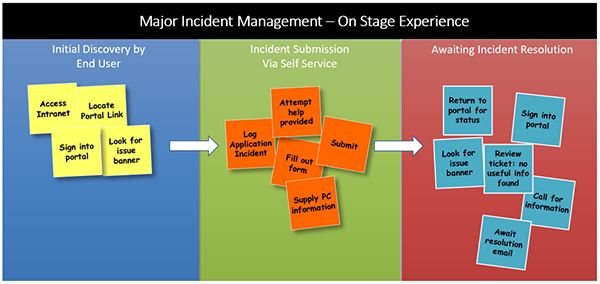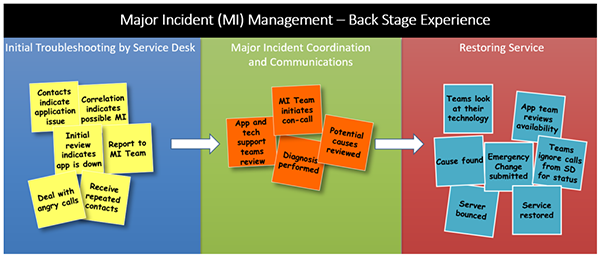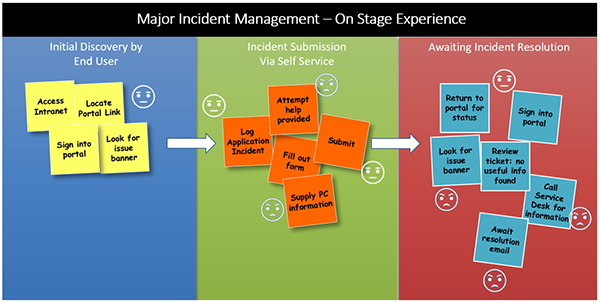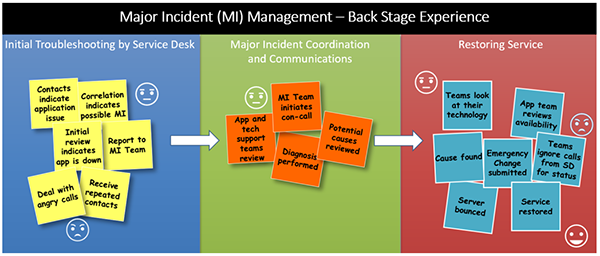Date Published August 22, 2018 - Last Updated December 13, 2018
Process documentation and adoption is a key aspect of maturing a service management practice, yet it is often performed in a painstakingly difficult and time-consuming manner, yielding complex processes that few understand and many fail to adopt, leaving them lying in a drawer gathering dust. Ideally, a well-designed process will improve performance and results, increasing the desire to adopt the process.
The answer to this dilemma is to simplify the methods used to develop and document a process, making it fast to define and easy to adopt. Journey mapping is a technique that can help. I’ll show you how-to map service management processes using journey mapping techniques combined with the creation of a roles matrix documenting responsibilities for the roles involved in the process.
Journey Mapping Described
Journey mapping is exactly what it sounds like: mapping a person’s journey through a process. Strictly speaking, when used for digital or user experience design, there is an on-stage experience map and a back-stage experience map created during the process. The on-stage experience is generally used to describe the consumer-facing aspect of the process, the back-stage describing the provider’s. The map itself is simply a representation of each step in the experience, mapped from start to completion. Emotions are then applied to each step, indicating improvement opportunities.
For process documentation and improvement programs, the best place to start is with the current experience, using it as a base to create the future state. The positive aspects are retained while bottlenecks and negative aspects are addressed in the process design sessions.
In its purest form, journey mapping is often combined with documenting personas. A persona is an organizational role and the person (or people) who occupy it. They are looked at from several dimensions: the services they provide and consume, their technology profile, their service profile (how they consume a service, and what channels they use).
For the purpose of mapping processes, journey mapping will be performed along with the creation of a RACI matrix, documenting both the process and each stakeholder’s role in the process, both of which are required to ensure adoption. To get started, choose a process to document.
Step 1: Map the Current State
After you select a process, the first step is to map the current state process along with a current roles matrix or RACI chart. With the key stakeholders gathered, define all of the roles who have a stake in the process, listing them across a board. Don’t forget all of the process consumers as this effort will involve then as well!
Next, begin to map the current state. For the purpose of this example, we will use the major incident management process. Using post-it notes, brainstorm all of the things that happen during a major incident from the customer’s point of view. The team can write them down using the post-its and then place them on a board in chronological order. It’s then a good idea to review and organize them, then document the map.
While creating the map, look at the players involved in this experience, along with the activities they perform. After the map is complete, fill in the RACI matrix for the activities and the roles that perform them. The journey map below shows a sample current state on-stage experience for a major incident (with the RACI following).
Once the on-stage experience is done, do the same for the back stage (IT) experience.
The on-stage experience, back-stage experience and RACI follow:



Step 2: Add Emotions to the Experience
Adding emotions to the experience enables the team reviewing the process to spot opportunities for improvement.

Viewing the on-stage experience, there are several emotions in play:
- There’s a neutral emotion about accessing the portal. Finding out why during focus group meetings might reveal that single-sign-on capabilities are needed as people don’t like having to log into the network and then onto the portal.
- There are some negative emotions around not finding help and having to provide PC information during the incident submission process. These too can be addressed. For example, good configuration management capabilities could have provided the PC information for confirmation or skipped the need to ask about it, especially for an issue that is not desktop related.
- Most of the negative emotions occur around not having regular communications and information about the major incident that is in progress. Procedures and accountability can assist here and should be considered while developing the process.

Adding emotions helps identify areas that need improvement. There could be many reasons for negative emotions in the major incident example:
- The end-user or consumer of the service is angry because they cannot do their job and will have to catch up later.
- Service desk personnel might be stressed because they can’t effectively manage the added call volume and because customers are angry.
- The incident manager might be stressed as they become a bottleneck and everyone’s circling waiting for information.
- The technicians might be annoyed about the conference calls used to manage the incident.
- Executives are annoyed about revenue loss caused by the issue.
The critical factor of this exercise is to identify the emotions and document the reasons for them, as this activity demonstrates what needs to be addressed when creating the future state.
Step 3: Create the Future State
This activity is nothing more than brainstorming ways to address the issues and changing out the post-it notes with improved activities or steps to be used and adjusting the RACI. The process is then documented along with the RACI.
This is where it now becomes important to widen participation, bringing in a focus group comprised of consumers and other members of the IT organization to provide feedback. This can be done in a single meeting, where the current and future state are presented and feedback is gathered.
The future state process should be mapped as shown in steps 1 and 2, and the RACI can then be adjusted and finalized for adoption. Before calling it a day, make sure to look at some of the critical success factors for the process and define some measures to know whether the effort will be a success.
Step 4: Create an Adoption and Communication Plan
While this blog doesn’t address adoption, this is the most important part of the process: educating participants in the process, gaining their buy in, and ensuring they are trained in it.
It will be important to use the original stakeholder group to look at the changes being made and for them to work together to create a communication and adoption program. There are several aspects to addressing this need:
- Document changes to people’s roles. Positive or negative, people hate change, so it’s important to acknowledge how their role may be changed and gain their buy-in.
- Document all of the process changes, along with how big a change it represents.
These become the base for your adoption program.
Step 5: Monitor Progress
On a continual basis, begin to run the identified reports. Create metrics that let the team know if the effort has been successful. If the results are not as expected, it will be important to identify whether the issue is lack of adherence, hence an adoption issue, or whether it’s process related.
These issues can be continually addressed, and improvement can continue until the organization and its use of the process have reached the desired level of maturity.
Benefits for All
Journey mapping has become popular in the world of user experience design because it clearly identifies areas where improvement is needed from both a process and personal perspective. As a result, leveraging this method for process development and improvement efforts can yield some positive impacts.
Rather than just looking at the activities, journey mapping considers the people who perform these activities and makes it very easy to sell the process changes, particularly when the result is less stress and less effort (or more organized work). Additionally, it provides process documentation that is easy for people to understand and follow. All of these aspects make it possible to gain higher levels of adoption more quickly, so the organization can begin to realize the benefits of the initiative.
Journey mapping considers the people who perform the activities and makes it easy to sell the process changes, particularly when the result is less stress and less effort.

Phyllis Drucker is an ITIL® certified consultant and information leader at Linium, a Ness Digital Engineering Company. Phyllis has more than 20 years of experience in the disciplines and frameworks of IT service management, as both a practitioner and consultant. She has served HDI since 1997 and itSMF USA since 2004 in a variety of capacities including speaker, writer, local group leader, board member, and operations director. Since 1997, Phyllis has helped to advance the profession of ITSM leaders and practitioners worldwide by providing her experience and insight on a wide variety of ITSM topics through presentations, whitepapers, and articles and now her new book on the service request catalog, Online Service Management: Creating a Successful Service Request Catalogue (International Best Practice). Follow Phyllis on Twitter @msitsm.